12.19.22
Pulling Back the Curtain: A Behind-the-Scenes Look at a Large-Scale LW Drama Production
For three shows— roughly 10 total on-stage hours—Lutheran West Drama took the audience back in time nearly 100 years to 1927. From April 8-10, 2022, the cast and crew of Singin’ in the Rain displayed stunning sets, fantastic acting, nimble dancing, and literally made it rain in the Jochum Performing Arts Center.
But how much preparation time do you think went into those three shows — the 10 hours of audience entertainment?
A month? Three months? Six months? Not even close.
“I’d been wanting to do Singin’ in the Rain for about a year,” Lutheran West Drama Director Caroline Pangrace said. “We probably changed our minds five or six times, but I wanted this show to be the musical. The previous year, we had The Addams Family as the spring musical, which is more modern. So in the name of variety, I knew that I wanted something classic.
“We’d been putting in the work on this as a group since mid-December 2021, but I’d been planning and working on it behind the scenes for well over a year.”
Pangrace, who credited her co-director Adam Zehnder ’08 for doing much of the detailed work that freed her to pull everything together, said it was amazing to see the various moving parts of the production come together: the set, the tech, the costumes, the dancing, and—of course—the acting.
“I’m always trying to find ways to push the students to explore their talents, and this show has it all,” Pangrace said. “Lots of sets, tap dancing, singing, some interesting tech challenges. I knew this was a show that would challenge the cast and crew, but one that they could
definitely pull off.”
To fully comprehend how a production the size of Singin’ in the Rain could come together, though, you should understand how each individual part was formed and molded.
The Set
The initial problem Pangrace faced was taking the various settings and backdrops from Singin’ in the Rain and making them fit onto the Jochum stage. “We have a fantastic performing arts center,” Pangrace said, “but it isn’t a Broadway stage or a movie set. We have space limitations that we need to work through with every show, and this one was no different.”
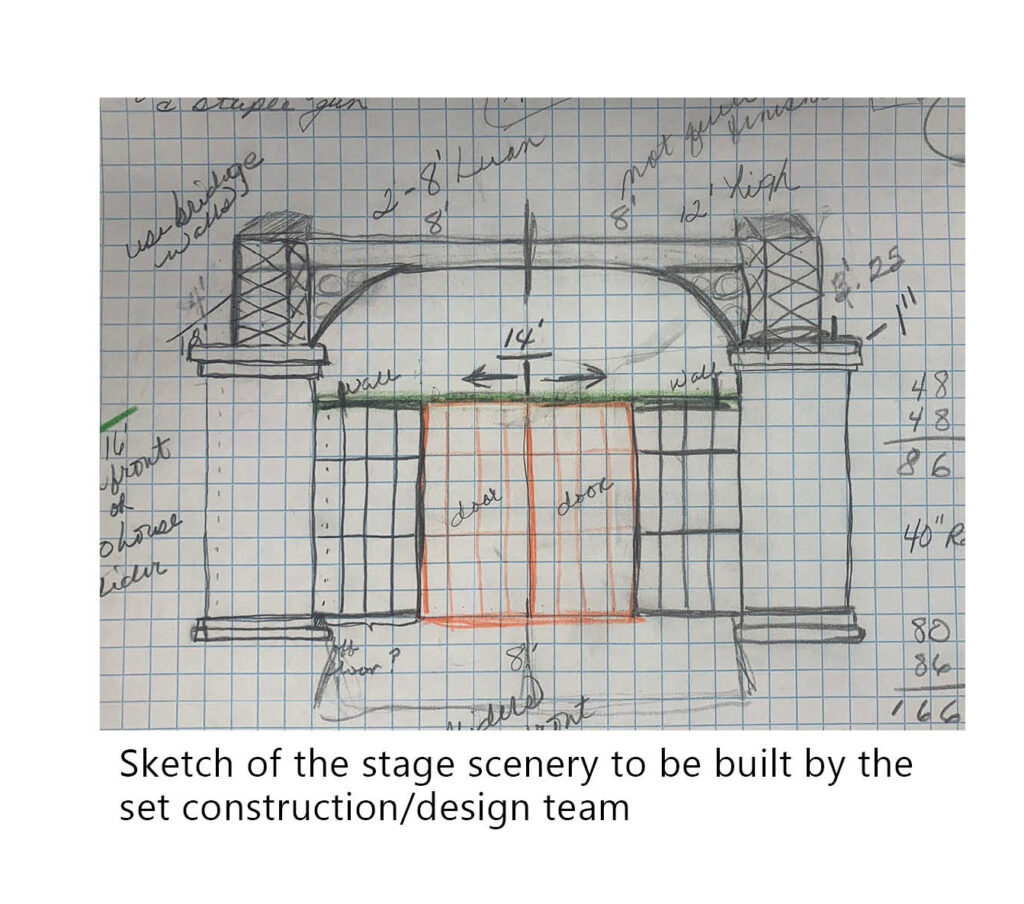
Going into preparations for Singin’ in the Rain, Stage Manager and 1st Assistant Director Livvy LoPiccolo ’22 was a veteran of five previous LW Drama productions, spending lots of time on set creation. She agreed that the sheer number of settings provided a unique challenge.
“The show has so many different scenes,” LoPiccolo said. “Obviously, we don’t have that kind of space. We had to find a way to make the set double up and work for a variety of scenes.”
LoPiccolo said that one of her key tasks as Stage Manager was to make the scenes and props come to life. While she had many visions in her head, translating them into reality was more work than she had originally anticipated.
“I have so many notebooks filled with ideas,” said LoPiccolo, who made her Stage Manager debut with the Fall 2020 performance of A Midsummer Night’s Dream. “If you went backstage, you’d see sketches everywhere. Different set and prop ideas and how they would fit together to make the show work. Some we were able to put together. Others never made it past the sketching stage. We would tape them on the wall and as they got completed, they would come down.
“It’s a strange obstacle to have so many ideas, but then you have to make adjustments and scrap some because you’re limited on space, materials, or time. But I didn’t view that as a bad thing. It was just another challenge to figure out.”
One way LoPiccolo realized she could save on space was by using the cast themselves to help move pieces of the set while performing on stage.
“It’s not reinventing the wheel or anything,” LoPiccolo said. “But when you have the actors moving the set pieces, it allows you to do more with less.
“Think about having a wall with an interior design on it. If you put that piece of set on wheels, you can turn it. So, your actors are starting a scene inside, maybe getting into a song. Part of the choreography can be to turn the wall and on the back side is the brick exterior
of the house. Just by adding wheels to the set, you created two different scenes that seamlessly flowed without the lights
having to go out to make the set changes.”
While it’s a great tactic to maximize stage space, a Stage Manager and the behind-the-scenes crew need the actors to fully buy in and understand how and why things work the way they do.
For actor Luke Wise ’24, one of the stranger parts was having so many moving pieces to the set.
“It’s definitely not anything new to have actors moving set pieces as part of a scene,” Wise, who played Rod, said. “The strange part was doing it while dancing or having multiple people move one piece to a specific spot so that other cast members could move it a few moments later. It was different, but something that was enjoyable to figure out.”
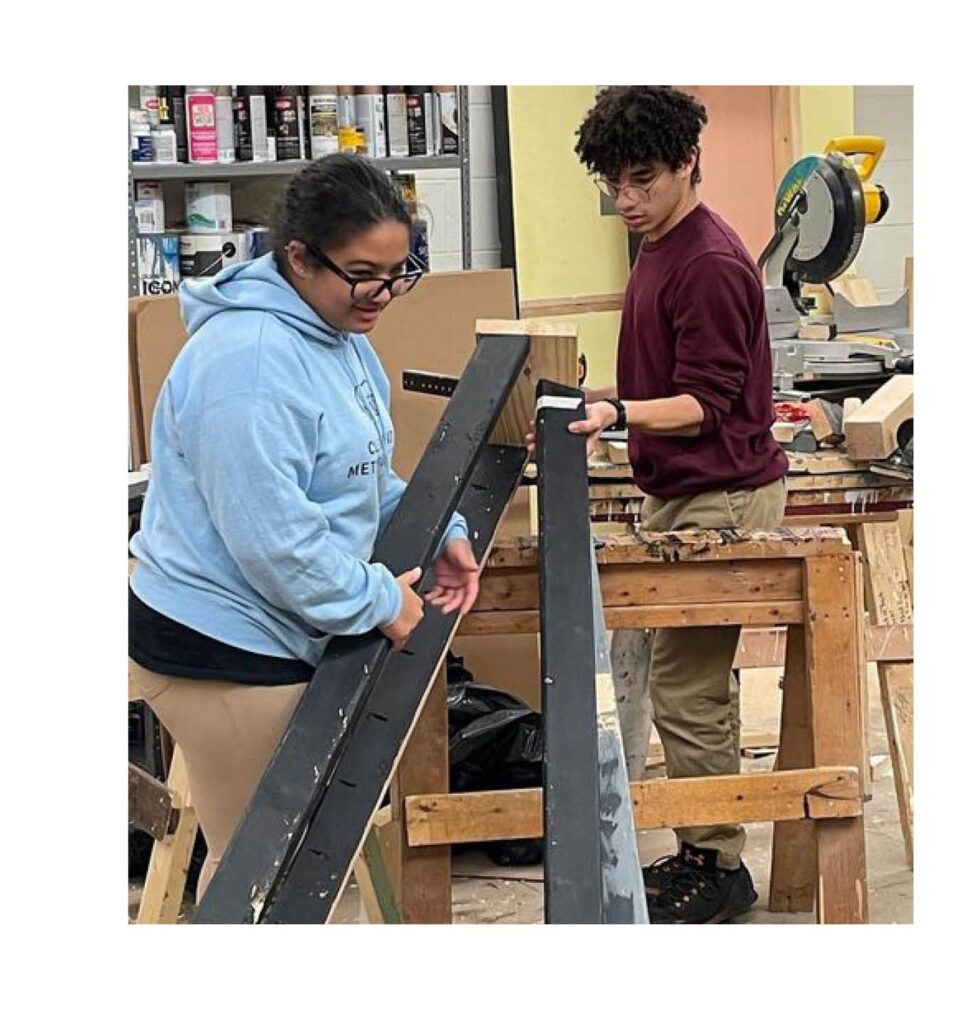
Another way that LoPiccolo managed to maximize the space was through the use of creative lighting — not only the stage lights, but including lights in the set itself. Something as simple as having a light-up sign that read “Monumental Pictures” was invaluable to creating and clarifying scenes.
“It’s a simple thing,” LoPiccolo said. “If the sign lights are on, you know the scene is at the movie set. If they’re off, the background is just another building. We tried to use those kinds of ideas as much as we could to create a lot of variety.”
But that’s just the set. There was also the task of taking the 5-6 props that each character needs throughout the play and keeping them organized backstage.
“Backstage, we have a couple of tables,” LoPiccolo said. “Each actor has a box on those tables with all of their props. I spend a lot of time backstage making
sure those boxes are where they need to be and organized by the time each prop is needed. My goal as Stage Manager is to make sure all the actors have to worry about is getting on stage and hitting their marks, not where their props might be.”
The Tech
For a play set in 1927, the technical equipment needed to bring the show to life was quite extensive. Just ask Joseph Rentas ’23, who was the sound captain for Singin’ in the Rain and integral to the technical aspects of the show.
“This one has been so involved,” Rentas, a four-show veteran of Lutheran West Drama, said. “Compared with other shows I’ve been involved in, there’s just been so much more to do. But I think that’s a good thing. I think it’s really apparent how much work we’ve put in.”
Just how much more in-depth was this show compared to others? In addition to microphones, sound effects, and lighting, Rentas and the tech crew had to find a way to show silent black-and-white films — which also had to be filmed by the cast well ahead of the show dates — in a spot that the whole audience could see it. He also had to ensure lighting would fit with a mobile set. Oh, and there was also the matter of making it rain—again, literally—on stage.
“It was just a bit more work than normal,” Rentas joked.
Rentas, who was also a key part of creating the set before shifting his focus to the tech side of things, said one of the most nerve-wracking parts of his job is the unknown.
“Doing tech is such a weird thing,” Rentas said. “I can only do so much in the months before the show. Most of my tech work has to happen in the last two or three weeks leading up to opening night. I think that’s what makes it so tough and kind of stressful. Everyone else is fine-tuning their stuff and I’m just kind of getting started.”
Rentas said he was fortunate to have some great friends that helped out, particularly when it came to completing the silent films projected on the wall to one side of the stage.
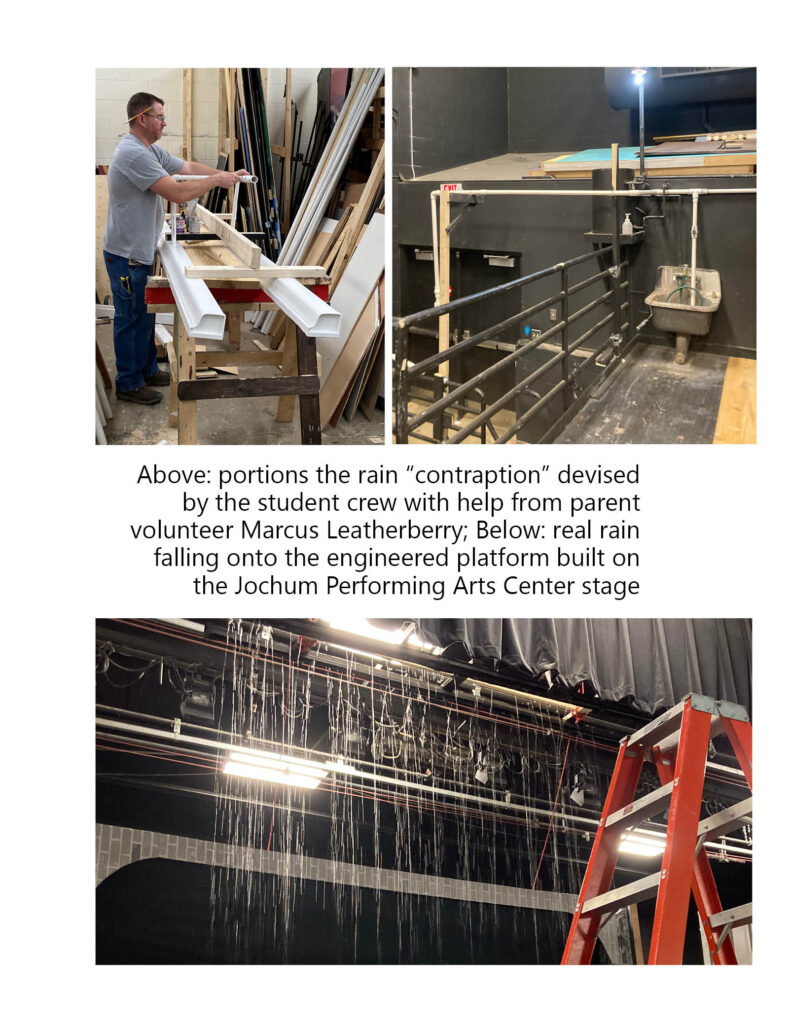
“I helped, but it was mostly my friends who are good with video editing that took care of editing the silent films,” Rentas said.
However, adding the projection aspect to the production created an interesting issue that Rentas had to solve: properly arranging speakers so that not only the audience, but the actors on stage could hear what was going on.
“It’s silent, but there’s still music in the background,” Rentas said. “We had to find a way to get the sound to the actors so they could know where things were timing-wise. They can’t easily see the projection, so if they can’t hear the music playing, it’s tough for them to know where things are.
“With that element, plus the ‘regular’ tech work of figuring out sound levels and which speakers should have which mics funneled into them, it’s a lot more than I think people realize.”
That is just leading up to the show. On opening night, things were as chaotic as ever for Rentas. In addition to running the soundboard for each show, he wore headphones to take live direction from Pangrace and Zehnder backstage.
“From the time the curtain goes up to the last bow, I’m busy,” Rentas said. “There’s been times where I even have to talk people through how to fix something backstage as I’m physically glued to my spot in the audience working the sound board.”
But what about the rain?
“That took some creative problem solving,” Pangrace said. “I knew I wanted it to rain on stage. How many high school performances have that happen? I knew if we could pull off real rain on stage, it would be one of those moments that people would be talking about for a long time.”Twice, rain fell on the stage of the Jochum. The first as Don Lockwood, played by Jacob Speicher ’22, closed out the first act by performing “Singin’ in the Rain,” and the second as the show closed with the ensemble singing the same song.
Using sump pumps, PVC piping, a gutter, and a trash can, rain successfully fell and was a true highlight of the performances.
Water was piped from a sink in the wings just off stage into a trash can. That trash can had two sump pumps which pumped the water above the stage into a gutter. Holes in the gutter caused the rain to fall on stage.
That was only half of the trick, though. After all, after the first rainfall, the water couldn’t simply sit on the stage with half the show left to go.
“The set crew designed a platform that the rain fell onto with a slight pitch to it and slits so that the water would drain,” Pangrace said. “It drained into some pipes that led to a garbage can with a sump pump, which would then run the water into the drain of the sink backstage.
“It was definitely a massive project. I’m so thankful to everyone involved with it, because the show truly wouldn’t have been the same without it.”
The Costumes
The fashion of the 1920s had defining characteristics which needed to be reflected on stage. The show’s costume designers were not interested in simply fitting the time period, however. They wanted as genuine a look as possible.
“Everything you see on stage is unique,” costume designer Emelie Kuenzer ’25 said. “We used the movie as our inspiration and tried to stay as true to the outfits as we could.”
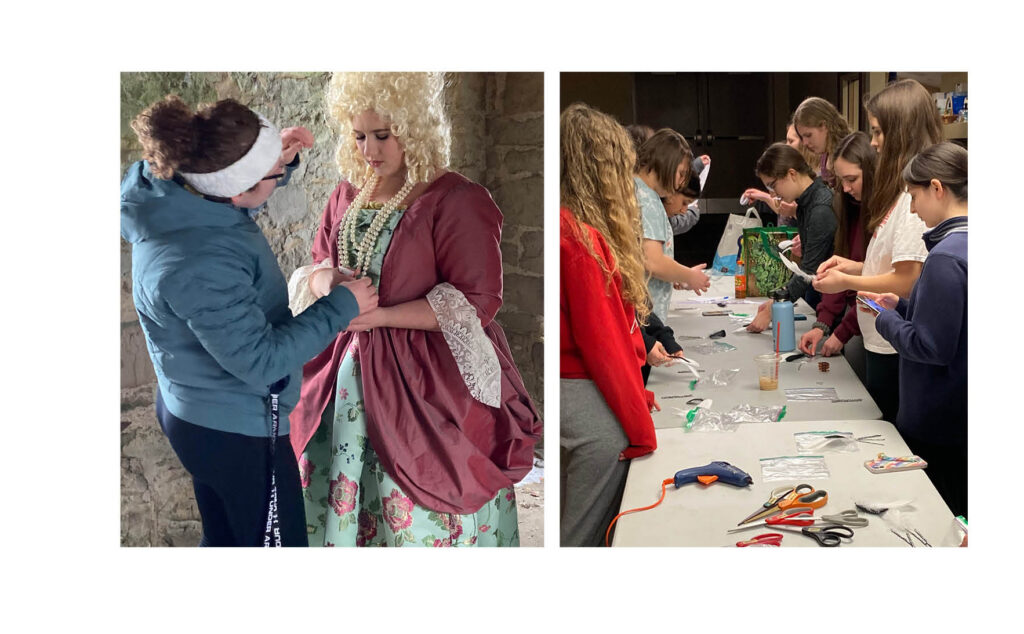
That meant the costume design team of 11 students and two adult leaders had to create nearly everything from scratch — with a few thrift store purchases thrown in and then altered to fit the production’s needs. However, despite an attempt to stay true to the classic 1952 movie, Kuenzer and the costume crew quickly realized they would have to make a few sacrifices in the name of functionality.
“In a live play, we often have to do quick costume changes—like less than a minute,” Kuenzer said. “That’s definitely not the case with a movie, where they can do multiple takes and can take their time to make adjustments between scenes. So there were a few cases where we had to go with something different than what was in the movie so that a quick change could happen.”
For Kuenzer, for whom this was only her second play at Lutheran West and first working in costume design, figuring out the intricacies of costume design was a steep learning curve she had to quickly master.
“When I started, I only knew how to use a sewing machine,” Kuenzer said. “Now, I know how do to darts and certain types of seams. I know about the different types of fabrics and what needs to be done for them. It was definitely a big learning experience, and a skill set I will have for my entire life.”
So, when did the costume team start working? Roughly two weeks before anyone else.
“It takes time to create everything we needed,” Kuenzer said. “In this show, the main characters were wearing about 8-10 outfits each, and the supporting cast and ensemble needed 5-6 each. So, we created well over 100 costumes.”
And that doesn’t even include any repair work or adjustments needed in the final rehearsals leading up to the performances.
“It’s a bit different with a musical production compared to a normal play,” Kuenzer said. “There’s a lot of dancing and movement in Singin’ in the Rain, so we had to make costumes that could be looser-fitting and stretch a bit. But you still could have seam rip or need to do some minor repairs.”
It’s not just leading into the performance that the costume team was hard at work — come showtime they were waiting in the wings for any repairs that might be needed.
“The clothes don’t care if it’s a rehearsal a month before the show or opening night,” Kuenzer said. “If it rips, it rips. And when I’m not on stage performing my small role, I’m waiting backstage or in the wings to help with quick costume changes or make any on-the-fly repairs needed.”
The Dancing
The art of dancing is an interesting one. Some people are great. Most people are not. And among all the dance styles out there, tap is not the most popular — particularly among high school kids.
Yet, Singin’ in the Rain required a large cast of high schoolers with minimal formal dance training to learn to tap dance.
“This might not be the easiest task,” Rachel Haggard ’23 said she thought upon learning that she would be a Dance Captain for the production. “I was just like, ‘Oh. Ok. I think I can do that.’”
As part of her duties, Haggard attended every choreography rehearsal and was integral in not only piecing the dances together, but also mastering each one so that she could teach the cast members.
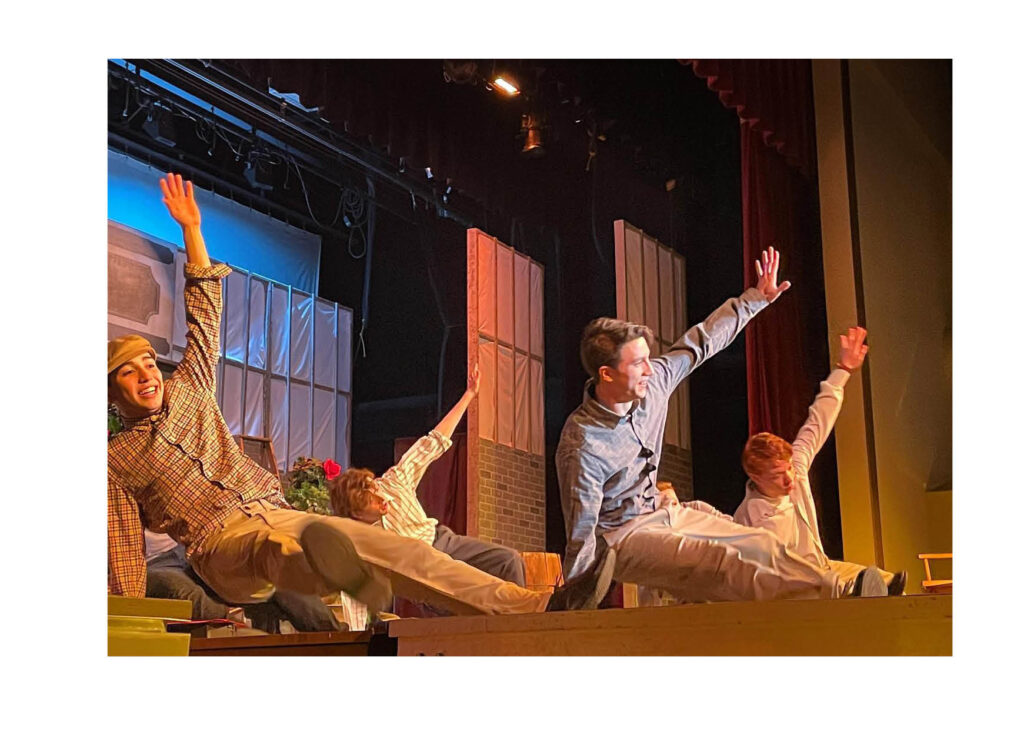
In other words, she had to know all the dances for every character.
“It was intense,” Haggard said. “It was difficult. There’s a lot of dances in the show, but it’s not just the number of dances. Each character has different moves to do within each dance.”
Learning all the dances was only half of the battle. Teaching them to the cast was the most daunting task for Haggard and her fellow Dance Captain, Ella Pierse ’23.
“There weren’t a lot of people who had a dance background,” Haggard said. “We had to get everyone to understand the basics of tap before we could really get them to learn their specific dances. It took a lot of work, but everyone was willing to put in the effort.”
Additionally, Haggard said that one of the strangest things was correcting her peers.
“I had a notebook in which I took notes on things we needed to work on as a group as well as individually,” Haggard said. “It was a bit weird at first talking with the cast about what they did wrong and what they had to fix, but they took the advice well and everyone understood that it wasn’t a criticism of them, which was fantastic.”
Haggard credits Pierse with handling the bulk of the work, specifically with getting everyone up to speed with tap dance.
“Ella is an Irish Dancer, so she’s been tapping since she was very young,” Haggard said. “The only experience I had with tap coming in to this show was from Newsies, which we did my freshman year. So, I’m super thankful I had Ella. I don’t think we would have been anywhere near as close to ready as we are without her.”
The Acting
Of course, no musical would be complete without the actors. They are tasked with taking all of the preparation hard work of the crew and bring the show to life on stage.
And, as with the other areas of Singin’ in the Rain, the work put in by the actors was much more in-depth than many other Lutheran West shows.
“On average, I probably put like 5-6 hours in per day into getting ready for this show,” said Wise. “It starts out a lot less, but as we get closer to opening night, I’m putting in closer to eight hours per day.”
Jacob Rentas ’23, who played Cosmo Brown, said that plenty of that time is doing the standard things. You learn your lines and really dig in to figure out who your character is, and how to best portray that person. The true challenge of a show like Singin’ in the Rain, though, comes from the tasks beyond the acting alone.
“With any show, you have to learn your lines and your marks,” Rentas said. “With a musical, though, you have to learn to sing and dance as well. And it’s not just standard dancing, it’s tap, which most people have no idea how to do and need to learn from scratch. Because of that, there was a lot more that went into learning our parts for this show.”
For Rentas, it was singing that proved to be the biggest hurdle. In addition to many duets and group songs, Rentas had one of the marquee songs, “Make ’Em Laugh,” in the first act.
“I’m relatively inexperienced compared to other people when it comes to singing,” Rentas said. “Last year was kind of my introduction to singing; I had to understand pitches and rhythm and timing. Even now, it’s still a challenge for me. I can get the acting down and the dancing down, but singing is where I had to really focus and take the time to get it up to where it needed to be.”
As with any show, Rentas said it all comes down to trial and error. The difference, though, is you have a lot more to figure out with a musical even though it’s generally prepared for in the same timeframe as any other stage show.
“We found out our roles in December 2021,” Rentas said. “The show was in early April 2022. So, we basically had three months and a few weeks to put everything together. It was a lot, but it was so much fun to do.
“The best part is seeing everything come together. It’s so rewarding to discover the best way to play your own character, but it’s really cool when you see someone else have a breakthrough. We’re all in this together and we’re all finding the way to the finish line as a group. So, when someone else has a breakthrough, the group has one. It’s just a really, really cool collaborative experience.”
Wise agreed.
“You become a family,” Wise said. “It’s awesome to see someone have a breakthrough on something when they were struggling with it. And I think those moments are what motivates all of us. You feed off the energy and everyone—and the final on-stage product—starts getting better.”
Visit LutheranWest.com/Drama for a photo gallery of the Fall 2022 play, CLUE On Stage: High School Edition, as well as updates on the Spring 2023 musical, The Music Man, coming to the Jochum Performing Arts Center Thursday – Sunday, March 30 – April 2.